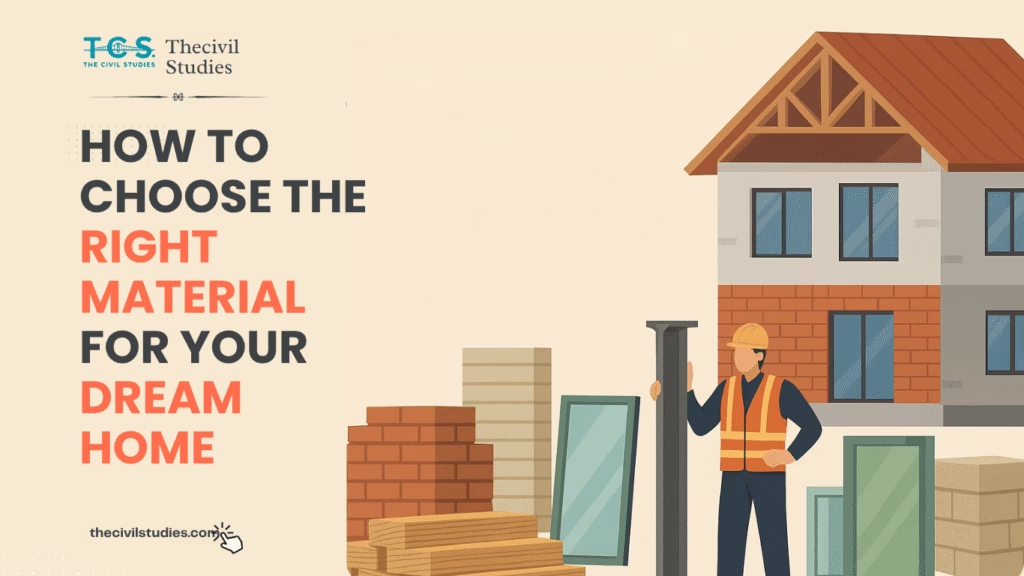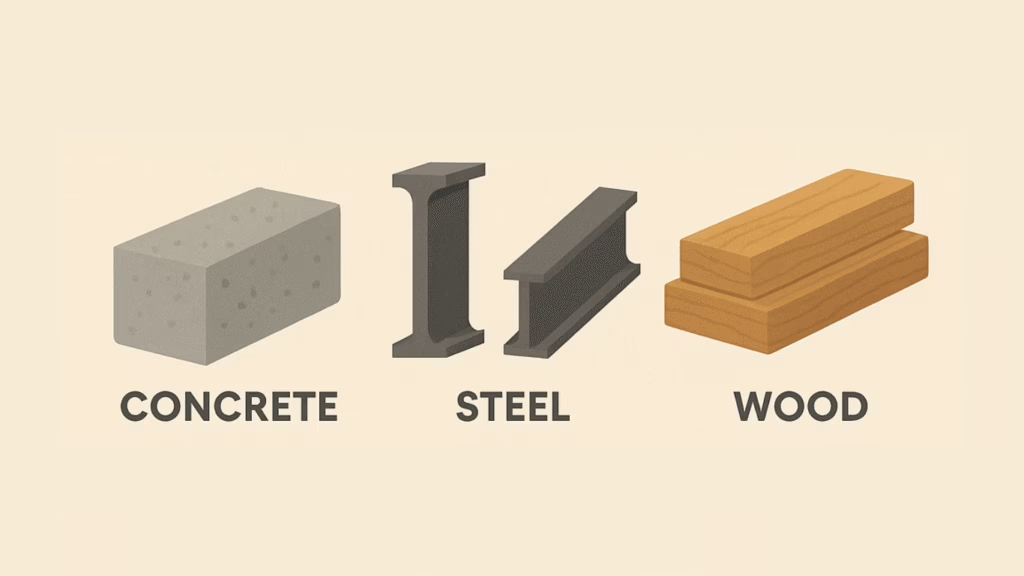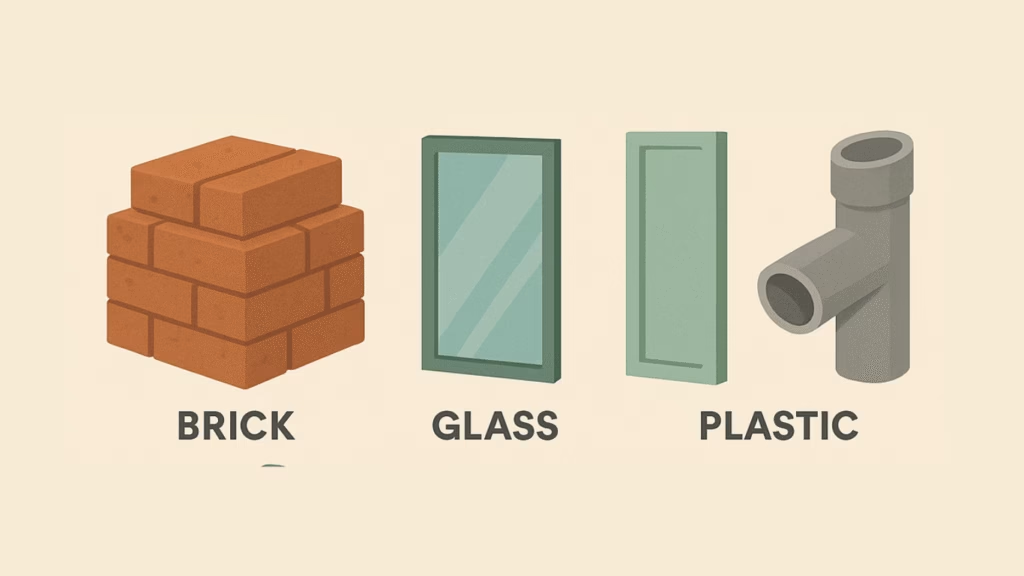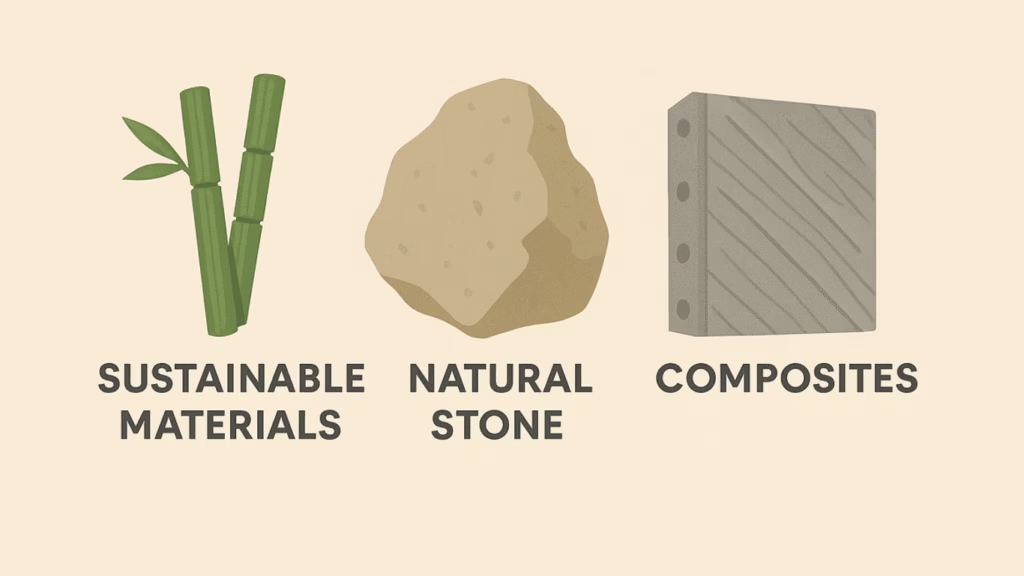
How to Choose the Right Building Materials for a Strong, Stylish & Sustainable Home
Why Your Building Material Choices Matter More Than You Think
When you’re planning to build or renovate your home, it’s easy to get caught up in the design, layout, and aesthetics. But here’s the truth—your home’s durability, energy performance, cost-efficiency, and even day-to-day comfort all depend on one key factor: the materials you choose to build with.
Whether you’re a first-time homeowner making decisions room by room or a civil engineer overseeing the big picture, understanding the pros and cons of various building materials can help you make choices that last a lifetime. In this guide, we’ll break down the most reliable, efficient, and widely used materials in home construction—each explained in clear, practical terms. Let’s help you build smarter, not harder.



Concrete – A Strong Foundation for Every Structure
Concrete is the backbone of most residential and commercial construction. It’s tough, affordable, and highly adaptable. Whether you’re pouring a slab, building a wall or laying a driveway concrete delivers strength that lasts for decades—especially when reinforced with steel.
What makes Concrete so reliable? Concrete has high compressive strength, meaning it can withstand heavy loads without cracking. It also resists fire, pests, and water when properly sealed. Plus, it can be molded into any shape before it hardens, giving architects and engineers lots of flexibility.
- Best for: Foundations, beams, columns, floors, and outdoor spaces
- Tip: Choose ready-mix concrete with additives like fly ash or slag for added sustainability.
2. Steel – When You Need Strength Without Compromise
Steel is a favorite among engineers for good reason. It’s incredibly strong, flexible, and lightweight compared to its load-bearing capacity. It can support large spans without the need for thick walls or columns, giving you more open and modern interior spaces.
It also scores high on sustainability—most steel is recycled and recyclable, whcih makes a smart choice for eco-conscious builders.
- Best for: Structural frames, roofing trusses, high-rise buildings
- Tip: Galvanized or coated steel resists corrosion and adds decades to your home’s life.
3. Wood – The Natural, Warm, and Renewable Choice
There’s something about wood that instantly makes a home feel warmer and more inviting. It’s been used in construction for centuries—and for good reason. Wood is lightweight, easy to work with, and naturally insulates against heat and cold.
As long as it’s responsibly sourced, wood is also a renewable material, making it both environmentally and aesthetically appealing.
- Best for: Framing, flooring, roofing, wall paneling, furniture
- Tip: Engineered wood products like cross-laminated timber (CLT) offer enhanced strength and sustainability with less waste.
4. Brick – Traditional, Timeless, and Fire-Resistant
Brick construction has stood the test of time—and for good reason. Bricks are strong, fire-resistant, and offer excellent thermal mass, which helps regulate indoor temperatures by absorbing and releasing heat slowly.
They’re also low maintenance, weather-resistant, and give your home that classic, timeless look.
- Best for: Exterior walls, fireplaces, garden walls
- Tip: Pair bricks with proper insulation to improve energy efficiency.
5. Glass – Letting in Light Without Losing Efficiency
Glass is more than just a transparent material—it’s a vital element in modern home design. It allows for natural daylighting, connects your indoors to outdoor views, and improves the visual appeal of a home.
Modern glass isn’t just beautiful—it’s functional. Double-glazed or low-E coated glass helps insulate your home while reducing noise and UV exposure.
- Best for: Windows, skylights, doors, room dividers
- Tip: Use laminated safety glass in areas exposed to impacts or harsh weather.
6. Plastic – Lightweight, Affordable, and Surprisingly Durable
Plastics are commonly used in building due to their lightweight nature, corrosion resistance, and low maintenance. You’ll find plastic in pipes, insulation boards, roofing membranes, and even in decorative panels.
They’re especially handy in areas where moisture, chemicals, or pests are a concern. And with increasing options for recycled plastic, they’re becoming more sustainable too.
- Best for: Plumbing, insulation, roofing membranes
- Tip: Go for high-density plastic (HDPE or uPVC) for longer lifespan and better performance.
7. Sustainable Materials – Building with the Future in Mind
Today, eco-conscious homeowners and builders are making smarter choices by turning to sustainable materials that are renewable, recyclable, or low in embodied energy.
Some popular eco-friendly building materials include:
- Bamboo – Rapidly renewable, strong, and attractive
- Reclaimed wood – Adds character while reducing logging
- Rammed earth & adobe – Excellent thermal mass and low carbon footprint
- Recycled steel & plastic – Reduces resource extraction and waste
- Best for: Green homes, sustainable housing projects
- Tip: Always check certifications like FSC (Forest Stewardship Council) or Cradle to Cradle for sustainable sourcing.
8. Natural Stone – Beauty That Lasts a Lifetime
Natural stone exudes elegance, strength, and durability. From glossy marble floors to rugged slate walls and timeless granite countertops, stone adds both luxury and longevity to a space.
It’s also naturally resistant to weather, moisture, and wear—making it a smart long-term investment.
- Best for: Flooring, cladding, countertops, patios
- Tip: Seal stone surfaces regularly to protect against staining and wear.
9. Ceramics – Hygienic, Durable, and Stylish
Ceramic materials are prized for their low maintenance, resistance to water and chemicals, and visual versatility. From bathroom tiles to exterior wall cladding, ceramics are durable, hygienic, and available in countless styles and textures.
- Best for: Bathrooms, kitchens, floors, walls
- Tip: Choose anti-skid ceramic tiles for wet areas to enhance safety.
10. Composite Materials – Modern Solutions for Modern Problems
Composite materials combine the best features of different substances to create products that are stronger, lighter, and more resilient. Two popular options include:
- Fibre-reinforced polymers (FRPs) – High tensile strength, corrosion-resistant
- Fibre cement boards – Great for cladding, partitions, and false ceilings
They’re often used in modern, energy-efficient homes where performance matters.
- Best for: Facades, external cladding, modular panels
- Tip: Use FRP in coastal areas or regions with high humidity for better performance than steel or wood.
11. Roofing Materials – The First Layer of Protection
A strong roof is essential for protecting your home from rain, heat, wind, and debris. Your choice of roofing material affects not just durability and weather resistance, but also energy performance.
Top roofing options include:
- Metal roofing – Long-lasting, reflective, fire-resistant
- Clay tiles – Traditional, durable, breathable
- Asphalt shingles – Budget-friendly, easy to install
- Synthetic membranes – Ideal for flat or low-slope roofs
- Best for: All climates—choose based on local weather and style
- Tip: Add reflective coatings or insulation layers under your roof to reduce heat gain.
12. Insulation Materials – For Comfort, Efficiency, and Lower Bills
Good insulation is the secret to a comfortable home—keeping it warm in winter and cool in summer. It also cuts down your energy usage and keeps outside noise at bay.
Popular insulation materials include:
- Fiberglass – Easy to install, budget-friendly
- Mineral wool – Great for fire resistance and soundproofing
- Foam boards – High R-value, moisture resistant
- Spray foam – Perfect for hard-to-reach or irregular areas
- Best for: Walls, ceilings, attics, basements
- Tip: Always check R-values to make sure your insulation meets climate zone requirements.
Conclusion: Build Better by Choosing Smarter
At the end of the day, a well-built home isn’t just about how it looks—it’s about how it performs, protects, and sustains. By understanding and choosing the right materials, you’re setting the foundation for a safer, more efficient, and more comfortable living space for years to come.
Whether you’re working with a builder or managing a project yourself, take the time to compare options, ask the right questions, and prioritize long-term quality over short-term savings.




